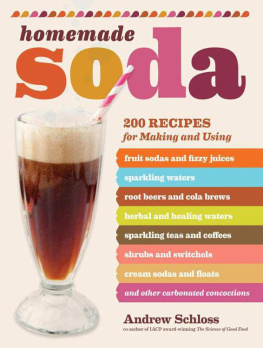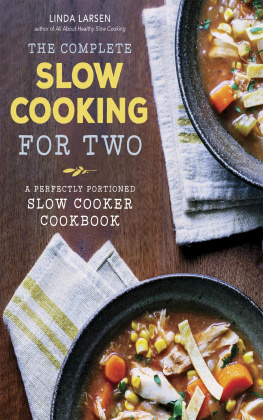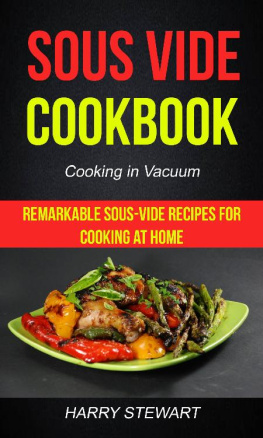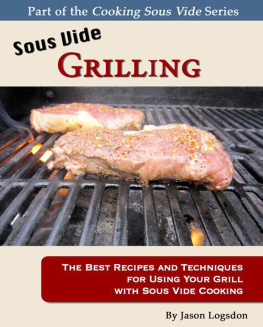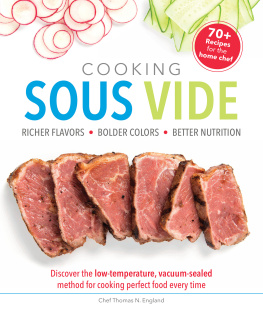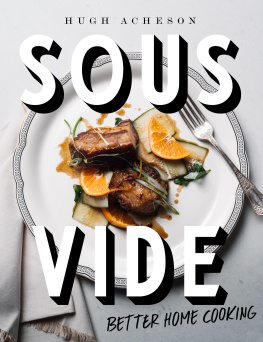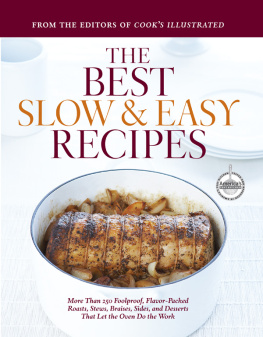
To Xander
Text copyright 2013 by Andrew Schloss.
Photographs copyright 2013 by Alan Benson.
All rights reserved. No part of this book may be reproduced in any form without written permission from the publisher.
ISBN 978-1-4521-2953-2
Library of Congress has previously cataloged this title under ISBN 978-1-4521-0469-0
Designed by Laura Palese and Alice Chau
Typesetting by Howie Severson
Chronicle Books LLC
680 Second Street
San Francisco, California 94107
www.chroniclebooks.com


INTRODUCTION

AN INVITATION TO RELAX
Cooking is a balance between time and temperature. Raise the heat and everything speeds up: flames jump, pots sizzle, grease spits. Lower the heat, however, and the turmoil subsides. Time stretches. Tough fibers soften. Beautifully complex flavors emerge. Aromas billow, and all you have to do is slow down and relax. Thats the magic of slow cooking.
Reconsidering this balance in the kitchen suggests a simple formula that can play out in many areas of our lives. The daily task of making dinner starts to shift. Your house transforms with heart-warming aromas, your family experiences genuinely delicious home-cooked meals, and you learn that by allowing food to cook untended all day, your work is reduced to minutes, while the good ingredients you purchased are being transformed in ways that only time can accomplish.
In a world where convenience is synonymous with speed, slowing down to save time seems like an oxymoron... but that is exactly what happens when you start to incorporate slow-cooking recipes into your cooking repertoire. You can set up a chicken for gentle roasting or a slow-baked casserole after morning coffee and bring it to the table at suppertime with little thought and no effort in between. You can be occupied elsewhere while your dinner simmers lazily, and by turning your oven or stove top into a slow cooker you find out that you can spend all day cooking, hands-free, with no sacrifice of quality, and no fear of overcooking.
LOW-TEMPERATURE COOKING
The term slow cooking captures the style and the principle of the process, but behind its magical results is simply the science of low-temperature cooking. Lets use roast beef as a prime example. The doneness temperature of a medium-rare rib roast is 130F/55C, meaning the protein in the meat has just begun to firm, making the meat resilient to the touch; the texture of the meat has lost its raw slickness but it is still moist and the juices flow from the meat when it is cut. The interior color has turned from dark to lighter red. If the beef was roasted in a 350F/180C/gas 4 oven, the exterior of the roast would have reached temperatures way above medium-rare in order for the center to get to the perfect temperature. At 400F/200C/gas 6, the changes to the outside of the roast would be even greater, and at that temperature misjudging timing could result in rapid overcooking.
But if the oven temperature is set at 130F/55C, the roast can never get any hotter than medium-rare. It is impossible to overcook it, even if it were left roasting for days. By moving the cooking temperature close to the doneness temperature, we minimize the danger of overcooking, which allows us to extend the cooking time to better fit a flexible schedule.
The advantage is much more than a matter of convenient timing. By keeping the temperature moderate, proteins firm more gently, making finished meats more tender, custards softer, fish moister, and casseroles creamier. The textural improvements from low-temperature cooking are remarkable, and yet many dishes cooked in a slow cooker come out mushy rather than succulent. The culprit is the water.
SLOW COOKERS VS. SLOW COOKING
The biggest difference between slow cooking in a slow cooker and any other piece of cooking equipment is water. There is much less evaporation from a slow cooker than there is from a saucepan or a skillet simmering on a stove top. The heat of a slow cooker is separated from the cooking vessel by a cushion of air, so the heat in a slow cooker is much more diffuse than the heat on a stove top; the liquid inside therefore transforms into steam more gradually. In addition, slow-cooker lids are usually made of glass, designed to stay relatively cool so that the steam rising from the cooking food precipitates back into water on the inside of the cooler lid, instead of sizzling away, as it would on the metal top of a Dutch oven, and drips back into the food.
This closed moisture system ensures that the heat in the cooker remains constant and the ingredients stay moist, one of the great advantages of cooking in a slow cooker. But it is not faultless and can be challenging to get perfect results, as preserving moisture inhibits flavors from concentrating. One of the principal ways that flavor develops in traditional cooking is through water evaporation: As the percentage of water reduces in a sauce, stew, or soup, the concentration of flavorful elements increases. At the same time, the percentage of solid particles increases and the liquid thickens. When slow-cooking in a slow cooker, neither happens, so the only way to end up with intense, dynamic flavors and smooth, creamy textures is to make sure theyre there before the slow cooker ever gets turned on. This is why slow-cooker recipes usually contain very little liquid and a generous amount of seasoning.
All of these drawbacks are eliminated by switching to slow cooking on a stove top or in an oven. Because ovens have lots of hot air between the food and the heating element, there is ample space for evaporation, so ingredients that are slow-roasted or slow-baked in an oven develop better flavor and richer textures than in a slow cooker.
The difference between roasting and baking (whether slow or fast) is largely semantic these days. At one time, roasting meant hanging a haunch of meat on a spit over an open fire. By keeping the meat at a distance from the flame, you could control the temperature and avoid burning it before it cooked through. By contrast, baking was done in metal or ceramic vessels placed to one side of the fire or buried in the smoldering coals. Food was placed in the pot, where it was protected from flame and could cook through without fear of scorching.
In time, ovens became large, freestanding units that could fit whole roasts, and eventually they took preference over the fireplace for roasting meat, largely because ovens did not require constant tending. Since then, the terms roasting and baking have become confused. For my purposes (aside from doughs, batters, and casseroles, all of which I bake), I roast whole meats and bake smaller cuts. For instance I would call the method for cooking a whole chicken roasting but refer to the method of cooking chicken parts as baking. But these distinctions are barely consistent. Like many other people, I roast vegetables even though they are almost always cut up, probably because they are cooked at a high enough temperature to scorch the edges, a traditional mark of roasting rather than baking.
The other common technique for slow cooking is simmering or braising, which can be done either on a stove top or in an oven. Both cook food in liquid, which helps to keep it moist, but more important, the presence of liquid controls temperature and timing. The maximum temperature of boiling water is 212F/100C, no matter how much heat is applied to the pan; that is, as long as there is water present, submerged food cant get hotter than 212F/100C. The technique just requires vigilance at the boiling point, when water is rapidly evaporating into steam and must be replenished regularly. In slow braising and simmering, the temperatures are kept far below a boil, so, for example, a brisket or pork shoulder simmering at 160 to 180F/71 to 82C can cook all day without losing moisture and without overcookingthe temperature of the liquid never gets hotter than you want the meat to be when it is done. Braising or simmering tougher cuts of muscled meats at these lower temperatures produces far more tender results than traditional braising temperatures.
Next page


